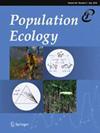Outbreaking forest insect drives phase synchrony among sympatric folivores: Exploring potential mechanisms
IF 1
4区 环境科学与生态学
Q4 ECOLOGY
引用次数: 1
Abstract
We explore a common feature of insect population dynamics, interspecific synchrony, which refers to synchrony in population dynamics among sympatric populations of different species. Such synchrony can arise via several possible mechanisms, including shared environmental effects and shared trophic interactions, but distinguishing the relative importance among different mechanisms can be challenging. We analyze interannual time series of population densities of the larch budmoth, Zeiraphera griseana (Lepidoptera: Tortricidae), along with six sympatric larch-feeding folivores from a site in the European Alps 1952 – 1979. These species include five lepidopterans, Exapate duratella , Ptycholomoides aeriferana , Spilonota laricana , Epirrita autumnata and Teleiodes saltuum , and one hymenopteran sawfly Pristiphora laricis . We docu-ment that the highly regular oscillatory behavior (period 9 – 10 years) of Z . griseana populations is similarly evident in the dynamics of most of the sympatric folivores. We also find that all of the sympatric species are phase synchronized with Z . griseana populations with half of the sympatric species exhibiting nonlagged phase synchrony and three of the species exhibiting 2 – 5 year lags behind Z . griseana populations. We adapt a previously developed tritrophic model of Z . griseana dynamics to explore possible mechanisms responsible for observed phase synchronization. Results suggest that either shared stochastic influences (e.g., weather) or shared parasitoid impacts are likely causes of nonlagged phase synchronization. The model further indicates that observed patterns of lagged phase synchronization are most likely caused by either shared delayed induced host plant defenses or direct density-dependent effects shared with Z . griseana .森林昆虫爆发驱动同域生叶动物的相位同步:探索潜在的机制
我们探讨了昆虫种群动态的一个共同特征,种间同步性,即不同物种的同域种群之间种群动态的同步性。这种同步性可以通过几种可能的机制产生,包括共同的环境影响和共同的营养相互作用,但区分不同机制之间的相对重要性可能具有挑战性。我们分析了1952年至1979年欧洲阿尔卑斯山一个地点的落叶松灰蝶(鳞翅目:灰蝶科)种群密度的年际时间序列,以及六种以落叶松为食的同域食叶夜蛾。这些物种包括五种鳞翅目,Exapate duratella,Ptycolomoides aeriferana,Spilonota laricana,Epirrita autumnata和Teleiodes saltuum,以及一种膜翅目锯蝇Pristiphora laricis。我们记录了Z的高度规则振荡行为(周期9-10年)。灰蝶种群在大多数同域食叶动物的动态中也同样明显。我们还发现,所有同域物种都与Z相位同步。灰蝶种群,其中一半的同域物种表现出非滞后相位同步性,其中三个物种表现出滞后Z 2-5年。灰蝶种群。我们采用了先前开发的Z的三营养模型。以探索观测到的相位同步的可能机制。结果表明,共享的随机影响(如天气)或共享的寄生蜂影响可能是非滞后相位同步的原因。该模型进一步表明,观测到的滞后相位同步模式很可能是由共享的延迟诱导宿主植物防御或与Z共享的直接密度依赖效应引起的。格里西安娜。
本文章由计算机程序翻译,如有差异,请以英文原文为准。
求助全文
约1分钟内获得全文
求助全文
来源期刊

Population Ecology
环境科学-生态学
CiteScore
3.90
自引率
11.80%
发文量
41
审稿时长
18-36 weeks
期刊介绍:
Population Ecology, formerly known as Researches on Population Ecology launched in Dec 1952, is the official journal of the Society of Population Ecology. Population Ecology publishes original research articles and reviews (including invited reviews) on various aspects of population ecology, from the individual to the community level. Among the specific fields included are population dynamics and distribution, evolutionary ecology, ecological genetics, theoretical models, conservation biology, agroecosystem studies, and bioresource management. Manuscripts should contain new results of empirical and/or theoretical investigations concerning facts, patterns, processes, mechanisms or concepts of population ecology; those purely descriptive in nature are not suitable for this journal. All manuscripts are reviewed anonymously by two or more referees, and the final editorial decision is made by the Chief Editor or an Associate Editor based on the referees'' evaluations.
 求助内容:
求助内容: 应助结果提醒方式:
应助结果提醒方式:


